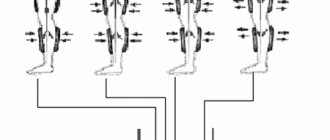Hypertrophic cardiomyopathy is a disease in which the heart muscle (myocardium) becomes abnormally thick or hypertrophied. This thickening of the heart muscle makes it much more difficult for the heart to pump blood. Hypertrophic cardiomyopathy can also negatively affect the heart's electrical system.
Hypertrophic cardiomyopathy often goes undetected because many patients are asymptomatic. Symptoms of this pathology are: shortness of breath, rhythm disturbances, up to the development of life-threatening conditions (arrhythmias).
Symptoms include the following:
- shortness of breath, especially during exercise or exertion;
- chest pain, especially during exercise;
- fainting, especially during exercise;
- dizziness;
- fatigue;
- cardiopalmus.
Symptoms of hypertrophic cardiomyopathy
Many people with HCM have either no or only mild symptoms and live normal lives. In other patients, symptoms may progress and worsen, thereby worsening heart function. Symptoms of hypertrophic cardiomyopathy can occur at any age and include:
- pain or pressure in the chest (usually occurs with physical exertion, but can also occur while resting or after eating)
- difficulty breathing (shortness of breath)
- fatigue (feeling extremely tired)
- fainting (due to irregular heart rhythms, abnormal functioning of blood vessels, or for no reason at all)
- rapid heartbeat (due to cardiac arrhythmias, usually ventricular extrasystoles, paroxysms of ventricular tachycardia, supraventricular arrhythmias are also common)
- sudden death (approximately 30% of patients have no complaints at all; sudden death may be the first and only manifestation of the disease.
Publications in the media
Hypertrophic cardiomyopathy (HCM) is a primary lesion of the heart, characterized by thickening of the walls of the left ventricle and the development of heart failure, predominantly diastolic • Hypertrophy of the left ventricular wall of more than 15 mm of unknown origin is considered a diagnostic criterion for HCM • The following options are distinguished •• Symmetrical HCM (enlargement involving all walls left ventricle) •• Asymmetric HCM (hypertrophy involving one of the walls): ••• apical HCM (hypertrophy covers only the apex of the heart in isolation) ••• obstructive HCM (interventricular septum or idiopathic hypertrophic subaortic stenosis ••• HCM of the LV free wall.
Important general features of HCM (both with and without obstruction) are a high frequency of cardiac arrhythmias, primarily ventricular extrasystole and paroxysmal tachycardia, and impaired diastolic filling of the left ventricle, which can lead to heart failure. Arrhythmias are associated with sudden death, which occurs in 50% of patients with HCM.
Statistical data. HCM is observed in 0.2% of the population, most often it is non-obstructive HCM (70-80%), less often - obstructive (20-30%, in the form of idiopathic hypertrophic muscular subaortic stenosis). Men get sick more often than women. The incidence is 3 cases per 100,000 people per year.
Etiology • Many HCM are hereditary diseases resulting from mutations in genes encoding myocardial contractile proteins. Familial hypertrophic cardiomyopathy: • type 1: 192600, MYH7, CMH1, 160760 (cardiac myosin, heavy chain b7), 14q12; • type 2: 115195, TNNT2, CMH2, 191045 (cardiac troponin 2), 1q32; • type 3: 115196, TPM1, CMH3, 191010 (tropomyosin cardiac 1), 15q22; •; type 4: 115197, MYBPC, CMH4, 600958 (myosin binding protein C), 11p11.2; • type 7: TNNI3, 191044 (cardiac troponin I), 19p13.2 q13.2; • with Wolff Parkinson-White syndrome: CMH6, 600858, 7q3
Pathogenesis. As a result of gene mutations, left ventricular hypertrophy and areas of cardiomyocyte disorganization occur.
• An increase in the content of calcium ions in cardiomyocytes and pathological stimulation of the sympathetic nervous system are important.
• Abnormally thickened intramural arteries do not have the ability to adequately dilate, which leads to ischemia, myocardial fibrosis and pathological hypertrophy.
• With asymmetric hypertrophy of the interventricular septum, according to the latest data, the obstruction is associated mainly with the abnormal forward movement of the anterior mitral valve leaflet into systole and, to a lesser extent, with septal hypertrophy (obstruction of the outflow tract of the left ventricle - muscular subaortic stenosis: the left ventricle is “divided” into two parts: a relatively small subaortic and a large apical; during the period of expulsion, a pressure difference occurs between them).
• Due to the presence of obstructions to normal blood flow, the pressure gradient between the left ventricle and the aorta increases, which leads to an increase in end-diastolic pressure in the left ventricle. Most patients have abnormal left ventricular systolic function.
• Regardless of the pressure gradient between the left ventricle and the aorta, patients with HCM have impaired left ventricular diastolic function, leading to increased end-diastolic pressure, increased pulmonary capillary wedge pressure, pulmonary congestion, left atrial dilatation, and atrial fibrillation. The development of diastolic dysfunction is associated with a decrease in compliance and impaired relaxation of the left ventricle •• Decreased compliance occurs due to increased muscle mass, a decrease in the left ventricular cavity and a decrease in myocardial compliance due to its fibrosis •• Deterioration of relaxation is the result of systolic (incomplete emptying of the left ventricle due to outflow tract obstruction) and diastolic (decreased ventricular filling) disorders.
• HCM in some cases is accompanied by myocardial ischemia, which is associated with the following reasons •• Reduced vasodilator reserve of the coronary arteries •• Abnormal structure of the intramural arteries of the heart •• Increased myocardial oxygen demand (increased muscle mass) •• Compression during systole of the arteries passing through the thicker myocardium •• Increased diastolic filling pressure •• In addition to the above reasons, 15–20% of patients experience concomitant atherosclerosis of the coronary arteries.
Pathomorphology • Macroscopic examination •• The main morphological manifestation of HCM is thickening of the walls of the left ventricle over 30 mm (sometimes up to 60 mm) in combination with normal or reduced dimensions of its cavity •• Dilatation of the left atrium (occurs due to increased end-diastolic pressure in the left ventricle ) •• In most patients, the interventricular septum and most of the lateral wall of the left ventricle are hypertrophied, while the posterior wall is less often involved in the process. In other patients, only the interventricular septum hypertrophies. In 30% of patients there may be local hypertrophy of the wall of the left ventricle of small sizes: the apex of the left ventricle (apical), only the posterior wall, the anterolateral wall. In 30% of patients, the right ventricle, papillary muscles or apex of the heart are involved in the hypertrophic process • Microscopic examination •• Disorderly arrangement of cardiomyocytes, replacement of muscle tissue with fibrous tissue, abnormal intramural coronary arteries •• The presence of disordered hypertrophy, characterized by multidirectional arrangement of myofibrils and unusual connections between neighboring myocardial cells •• Foci of fibrosis are represented by randomly intertwined bundles of coarse collagen fibers.
Clinical manifestations are caused by obstruction of the left ventricular outflow tract, its diastolic dysfunction, myocardial ischemia and cardiac arrhythmias
• Sudden cardiac death is possible, most cases (80%) resulting from ventricular fibrillation. Other causes of sudden cardiac death include atrial fibrillation with a high ventricular rate, supraventricular tachycardia, and a sharp decrease in cardiac output with the development of shock. Risk factors for sudden cardiac death in HCM include the following •• History of cardiac arrest •• Persistent ventricular tachycardia •• Severe left ventricular hypertrophy •• Genotype features (see Etiology) or family history of sudden cardiac death •• Frequent paroxysms of ventricular tachycardia, detected by daily ECG monitoring •• Early appearance of symptoms of HCM (in childhood) •• Frequent fainting •• Abnormal response of blood pressure to physical activity (decrease).
• Complaints •• The disease can be asymptomatic for a long time, and it is accidentally detected during examination for another reason •• Shortness of breath as a result of an increase in diastolic filling pressure of the left ventricle and a passive retrograde increase in pressure in the pulmonary veins, which leads to impaired gas exchange. An increase in left ventricular filling pressure is due to worsening diastolic relaxation due to severe hypertrophy •• Dizziness and fainting during exercise as a result of worsening cerebral circulation due to worsening obstruction of the left ventricular outflow tract. Also, episodes of loss of consciousness can be caused by arrhythmias •• Chest pain due to worsening diastolic relaxation and increased myocardial oxygen demand as a result of hypertrophy. Typical attacks of angina pectoris may occur, the causes of which are a discrepancy between the coronary blood flow and the increased oxygen demand of the hypertrophied myocardium, compression of the intramural branches of the coronary arteries by subendocardial ischemia as a result of impaired diastolic relaxation •• Palpitations can be a manifestation of supraventricular or ventricular tachycardia, atrial fibrillation.
• Upon examination, there may be no external manifestations of the disease. In the presence of severe heart failure, cyanosis is detected. HCM can be combined with arterial hypertension.
• Palpation can reveal a double apical impulse (contraction of the left atrium and left ventricle) and systolic tremor at the left edge of the sternum.
• Auscultation of the heart •• Heart sounds are usually not changed, although there may be a paradoxical splitting of the second tone with a significant pressure gradient between the left ventricle and the aorta •• The main auscultatory manifestation of HCM with obstruction of the outflow tract of the left ventricle is systolic murmur ••• The occurrence of systolic murmur is associated with the presence of an intraventricular pressure gradient between the left ventricle and the aorta and mitral regurgitation (reflux of blood into the left atrium as a result of prolapse of one of the mitral valve leaflets due to excess pressure in the left ventricle) ••• The murmur has a waxing-waning character and is better heard between the apex of the heart and the left edge of the sternum. It may radiate to the axillary region ••• The murmur decreases (due to decreased obstruction of the left ventricular outflow tract) with decreased myocardial contractility (for example, due to the use of beta-blockers), an increase in left ventricular volume, or an increase in blood pressure (for example, in the squatting position, taking vasoconstrictors) ••• The murmur increases (due to increased obstruction) as a result of increased contractility (for example, during physical activity), a decrease in left ventricular volume, a decrease in blood pressure (for example, with the Valsalva maneuver, taking antihypertensive drugs, nitrates).
Instrumental data
• ECG changes in HCM are detected in 90% of patients •• Main ECG signs: left ventricular hypertrophy, changes in the ST segment and T wave, the presence of pathological Q waves (in leads II, III, aVF, chest leads), atrial fibrillation and flutter , ventricular extrasystole, shortening of the P–R (P–Q) interval, incomplete blockade of the His bundle branches. The causes of pathological Q waves are unknown. They are associated with myocardial ischemia, abnormal activation of the interventricular septum, imbalance of the resulting electrical vectors of the interventricular septum and the wall of the right ventricle •• Less commonly, ventricular tachycardia and atrial fibrillation are recorded on the ECG in patients with HCM •• With apical cardiomyopathy, “giant” negative T waves often occur ( depth more than 10 mm) in the chest leads.
• Daily ECG monitoring: supraventricular arrhythmias are detected in 25–50% of patients with HCM, ventricular tachycardia is detected in 25% of patients.
• EchoCG is the main method for diagnosing this disease •• Determine the localization of hypertrophied areas of the myocardium, the severity of hypertrophy, and the presence of obstruction of the outflow tract of the left ventricle. Asymmetric hypertrophy is detected in 60%, symmetric in 30%, apical in 10% •• In Doppler mode, the severity of mitral regurgitation and the degree of pressure gradient between the left ventricle and the aorta are determined (a pressure gradient of more than 50 mm Hg is considered pronounced). In addition, Doppler can also detect concomitant mild or moderate aortic regurgitation in 30% of patients with HCM •• In 80% of patients, signs of left ventricular diastolic dysfunction can be detected •• Left ventricular ejection fraction may be increased •• Signs of HCM also include • •• small size of the cavity of the left ventricle ••• dilatation of the left atrium ••• reduced amplitude of movement of the interventricular septum with normal or increased movement of the posterior wall of the left ventricle ••• mid-systolic closure of the aortic valve leaflets •• The following are considered signs of obstructive HCM ••• Asymmetric hypertrophy of the interventricular septum with a ratio of its thickness to the thickness of the posterior wall of the left ventricle more than 1.3:1 (and the thickness of the interventricular septum should be 4–6 mm greater than normal for this age group) ••• Systolic movement of the anterior leaflet of the mitral valve forward.
• X-ray examination: the contours of the heart may be normal. With a significant increase in pressure in the pulmonary artery, bulging of its trunk and expansion of its branches are noted.
Diagnostics. The main diagnostic method is echocardiography, which allows to detect myocardial thickening and assess the presence of obstruction of the left ventricular outflow tract. Before diagnosing HCM, it is necessary to exclude causes of secondary hypertrophy, incl. acquired and congenital heart defects, arterial hypertension, coronary artery disease, etc.
Differential diagnosis • Other forms of cardiomyopathy • Aortic stenosis • Mitral valve insufficiency • IHD.
TREATMENT
General recommendations. In case of HCM (especially in the obstructive form), it is recommended to avoid significant physical activity, since this may increase the pressure gradient between the left ventricle and the aorta, causing cardiac arrhythmias and fainting.
Drug therapy • For asymptomatic HCM, it is possible to prescribe b-blockers (from 40 to 240 mg/day propranolol, 100–200 mg/day atenolol or metoprolol) or slow calcium channel blockers (verapamil at a dose of 120–360 mg/day), although this issue still remains controversial • In the presence of moderately severe symptoms, either b-blockers are prescribed (propranolol in a dose of 40 to 240 mg/day, atenolol or metoprolol in a dose of 100–200 mg/day) or slow calcium channel blockers (verapamil in dose 120–360 mg/day). They decrease heart rate and prolong diastole, increase passive left ventricular filling, and decrease filling pressure. Similar therapy is also indicated for atrial fibrillation. In addition, due to the high risk of thromboembolism in atrial fibrillation, patients should be prescribed anticoagulants • For severe symptoms of HCM, in addition to b-blockers or verapamil, diuretics are prescribed (for example, hydrochlorothiazide at a dose of 25–50 mg/day) • For obstructive HCM the use of cardiac glycosides, nitrates, and adrenergic agonists should be avoided • In obstructive HCM, it is necessary to prevent infective endocarditis, since vegetations may appear on the anterior leaflet of the mitral valve as a result of its constant trauma.
Surgery. Surgical treatment is carried out for the obstructive form of HCM with a pressure gradient between the left ventricle and the aorta of more than 50 mm Hg. In this case, septal myotomy-myectomy (Morrow operation) is performed. In the presence of frequent paroxysms of ventricular tachycardia, they resort to implantation of a cardioverter-defibrillator.
The course is variable. In most patients, the disease is relatively stable or even tends to improve (in 5–10% over 5–20 years). Women with HCM usually tolerate pregnancy well. With a long course of the disease, the development of heart failure is increasingly observed.
Prognosis • Without treatment, the mortality rate of patients with HCM is 2–4% per year • Patients with more than one risk factor for sudden cardiac death are classified as a high-risk group • In 5–10% of patients, spontaneous reverse development of hypertrophy is possible • In 10%, the transition to hypertrophic cardiomyopathy into dilated cardiomyopathy • In 5–10% of patients, a complication develops in the form of infective endocarditis.
Concomitant pathology • Arrhythmias • Systemic arterial hypertension • Aortic stenosis • IHD.
Reduction. HCM is hypertrophic cardiomyopathy.
ICD-10 • I42.1 Obstructive hypertrophic cardiomyopathy • I42.2 Other hypertrophic cardiomyopathy.
Recommendations
Diet
Drinking plenty of fluids is very important. Drink at least 6 to 8 glasses of water per day. In hot weather, you should increase your fluid intake. Fluids and salt restrictions are necessary for patients with heart failure. Talk to your healthcare provider about how specific liquids and diet drinks affect your body, including information about the effects of alcohol and caffeine.
Physical exercise
Your doctor will tell you whether exercise is recommended for you or not. Most people with cardiomyopathy are offered light aerobic exercise. However, your doctor may ask you to avoid any physical activity based on your symptoms and the severity of your illness. As with dilated cardiomyopathy, heavy lifting is not recommended
Regular doctor visits
Patients with HCM should visit a cardiologist at least once a year to monitor their condition. Visits to the doctor may be more frequent when hypertrophic cardiomyopathy is first diagnosed.
Causes of the disease
Hypertrophic cardiomyopathy is usually caused by gene mutations. These mutations are thought to cause the heart muscle to grow abnormally thick. People with hypertrophic cardiomyopathy also have altered alignment of the heart muscle fibers. And the cells in the fibers stop contracting synchronously, which often leads to heart rhythm disturbances.
The severity of hypertrophic cardiomyopathy varies widely. Most people with hypertrophic cardiomyopathy have a form of the disease in which the interventricular septum (the partition between the two lower chambers of the heart) becomes significantly enlarged, impeding blood flow. This condition is called hypertrophic obstructive cardiomyopathy.
Another common form of the disease is cardiomyopathy without significant obstruction to blood flow. However, in this case, the elasticity of the heart muscle suffers, the myocardium becomes rigid, which reduces the amount of blood ejected by the heart into the vascular system with each contraction. This form is called non-obstructive hypertrophic cardiomyopathy.
What drugs are used to treat hypertrophic cardiomyopathy?
Medicines used to treat symptoms and prevent further complications of HCM take the strain off the heart and reduce barriers to efficient blood circulation in the body. In the treatment of hypertrophic cardiomyopathy, medications based on beta-blockers are also used, which can reduce the load on the heart by lowering pressure and pulse, reducing myocardial hypertrophy. Beta blockers also have antiarrhythmic effects, including the ability to reduce the risk of fatal arrhythmias and sudden death.
Your doctor may ask you to avoid certain medications, such as nitrates (which lower blood pressure) or digoxin (which increases the force of your heart's contractions).
Your doctor will advise which medications are best for you.
Surgical procedures used to treat hypertrophic cardiomyopathy
Surgical techniques used to treat HCM include:
Transaortic septal myectomy. This technique involves reducing obstruction by reducing the thickness of the interventricular septum.
Transcatheter septal alcohol ablation. The introduction of sclerosing substances such as alcohol solutions, the creation of infarction zones in the interventricular septum.
Implantation of an artificial mitral heart valve. This type of surgery is offered to patients at high risk for life-threatening arrhythmias and sudden cardiac death. The mitral valve constantly monitors the heart rhythm. When it detects an abnormal, very fast heart rhythm, by supplying energy to the heart muscle, it causes the heart to beat at a normal rhythm.
Diagnostics
- An echocardiogram (ultrasound of the heart) is the most common test for diagnosing hypertrophic cardiomyopathy. With an echocardiogram, your doctor can see the thickness of your heart muscle, whether blood flow is abnormal, and the condition of your heart valves. An echocardiogram uses sound waves to produce an image of the heart. Echocardiography allows the doctor to see the heart in motion—as the ventricles contract and valves open and close.
Types of echocardiogram include:- Transthoracic echocardiography. This is a standard echocardiogram. The ultrasound doctor works using an ultrasound wave sensor, moving it along the surface of the chest. The sensor detects sound waves reflected from the heart. The computer converts them into moving images on the monitor.
Transesophageal echocardiography. In this type of echocardiography, a flexible tube containing a transducer is passed into the esophagus. From there, more detailed images of your heart can be obtained. Your doctor may order a transesophageal echocardiogram if it is difficult to get a clear picture of your heart during a standard ultrasound.
- Electrocardiogram (ECG). This test records the electrical activity of your heart. This is done to detect abnormal electrical signals that may result from thickening of the heart muscle.
- Holter monitoring. This is a simple test in which an ECG is recorded continuously for one or two days. It is used to detect abnormal heart rhythm.
- Coronary angiography. Sometimes, a doctor may use this test to rule out other heart pathologies. The catheter is inserted through a puncture into the artery in the thigh. Then you are carefully guided to the chambers of your heart under the guidance of an X-ray machine, which shows real-time images of your heart.
- MRI of the heart. Cardiac magnetic resonance imaging (MRI) is a method of producing images using magnetic fields and radio waves. Cardiac MRI is often used in addition to echocardiography, especially if echocardiographic findings are inconclusive.
- The question of genetic testing is determined by the doctor in each specific case.
If you have parents, siblings, or children with hypertrophic cardiomyopathy, experts recommend that you be regularly screened for signs of this condition.
The recommendation is to have an echocardiogram (ultrasound of the heart) and an electrocardiogram once a year. Over time, this diagnosis can be performed once every 5 years.
Sudden death and endocarditis in hypertrophic cardiomyopathy
A small number of people with HCM are at increased risk of sudden cardiac death. People who are included in this risk group:
- relatives of those who died from sudden cardiac death
- young people with HCM with multiple episodes of loss of consciousness
- patients with high blood pressure and arrhythmia
- patients with severe symptoms and heart failure
If you have two or more risk factors for sudden cardiac death, your doctor will prescribe medications to prevent the arrhythmia. Most patients with HCM have a low risk of sudden cardiac death. Talk to your doctor about any problems you may face with hypertrophic cardiomyopathy.
Risk factors
Hypertrophic cardiomyopathy affects men and women equally.
The disease is transmitted, as a rule, by inheritance. There is a 50% chance that the children of those who suffer from hypertrophic cardiomyopathy will inherit a genetic mutation that subsequently leads to the development of the disease. Siblings of those with hypertrophic cardiomyopathy are also at risk. As a result, close relatives of those suffering from hypertrophic cardiomyopathy are strongly advised to consult a doctor to rule out the disease.
Drug treatment
Medicines are prescribed to relax the heart muscle and slow the heart rate so it can work more efficiently. For this, beta-blockers such as metoprolol (Lopressor, Toprol), propranolol (Inderal, Innopran XL) or atenolol (Tenormin) are recommended; calcium channel blockers such as verapamil (Verelan, Kalan, Kovera-XC) or diltiazem (Cardizem, Tiazac, Dilacor XR); or drugs to control heart rhythm such as amiodarone (Cordarone, Paserone) or disopyramide (Norpase).
For atrial fibrillation, taking blood thinners such as warfarin (Coumadin, Jantoven), dabigatran (Pradaxa), rivaroxaban (Xarelto), or apixaban (Eliquis) is recommended to reduce the risk of blood clots.
Overcoming difficulties
The diagnosis - hypertrophic cardiomyopathy - does not cause positive emotions. However, it should not be a cause of depression either. Cardiomyopathy is a curable disease, the method of treatment depends on its type and severity.
Because hypertrophic cardiomyopathy is inherited, it cannot be prevented. However, doctors and scientists are learning more about the genetic mutations that cause the disease. And it is important to identify this condition as early as possible so that treatment and prevention of complications can significantly help your health.








